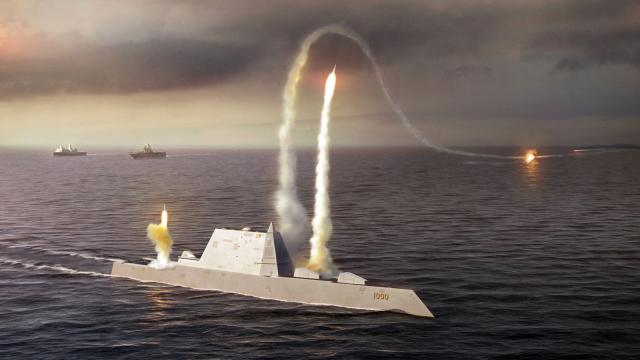America possesses the most formidable naval fleet in the world. However, the face of oceanic warfare is rapidly evolving and bears little resemblance to 20th century sea battles. Naval dominance is no longer decided in the middle of the Pacific or Atlantic, but rather in shallow territorial waters. To meet these new offshore challenges, the US Navy has spent years and billions on a new class of Destroyer.
Dubbed the Zumwalt-class in honour of Admiral Elmo R. “Bud” Zumwalt Jr., Chief of Naval Operations from 1970 to 1974, these ships grew out of the older DD21 “21st Century Destroyer” program when Congress gutted its funding in 2001. The program originally called for more than 300 Zumwalts to be built but cost overruns have seen the program shrink to two dozen, then seven, and now just three ships. However, given the estimated capabilities of these multi-role destroyers, seven should be more than enough to handle most anything foreign powers can throw at them.
The first such vessel, the one that was (Update: supposed to be) christened on October 19, is demarked DD 1000 and is built with surface warfare, anti-aircraft, and naval fire support missions in mind. It features an all-composite superstructure and “tumblehome” hull, in that it slopes inward above the waterline much like the old Civil War Ironclad, that drastically reduces the ship’s radar cross-section (much like the angular form of the F-117 Nighthawk). This means that even though the Zumwalts — at 185m long with a 24m beam and 8.5m draft — are nearly 40 per cent bigger than the previous Arleigh Burke-class, they register about the same size as Lt Dan’s fishing boat on the radar screen and are just slightly louder than a Los Angeles-class submarine. That stealthiness comes at a price though; tumblehome designs are notoriously unstable when quickly turning and when firing ordnance. To counter that effect, Zumwalts can release ballast and sink lower into the ocean when the going gets rough. What’s more, the new hull is designed to cut through the waves, rather than bounce over them, in order to improve stability.
The inside of the ship is divided into a series of 16 Electronic Modular Enclosures (EMEs). These independent boxes shield the boat’s delicate electronics — packed into some 235 electronics cabinets per EME — from electromagnetic interference, shock, and vibration during even the most hectic battles.
The Zumwalt-class’ electronics utilization extends to its power and propulsion systems as well. The ship’s 78 MW Integrated Power System (IPS) employs a pair of Rolls-Royce Marine Trent-30 gas turbines driving two Curtiss-Wright generators that in turn drive the two Advanced Induction Motors (AIM) that turn the propellers. This setup significantly reduces thermal and audible signatures, though it wasn’t the Navy’s first choice. The Zumwalts were originally meant to use Permanent Magnet-Synchronous Motors (PMM), but due to scheduling and reliability concerns, the Navy switched over to AIMs during the construction process. According to Defence Industry Daily:
…The exact choice of engine systems remains somewhat controversial at this point. The concept was originally for an integrated power system (IPS) based on in-hull permanent magnet synchronous motors (PMMs), with Advanced Induction Motors (AIM) as a possible backup solution. The design was shifted to the AIM system in February 2005 in order to meet scheduled milestones; PMM technical issues were subsequently fixed, but the program has moved on. The downside is that AIM technology has a heavier motor, requires more space, requires a “separate controller” to be developed to meet noise requirements, and produces one-third the amount of voltage. On the other hand, these very differences will force time and cost penalties from design and construction changes if the program wishes to “design AIM out”…
Still, these motors are easily capable of moving the 10,886-tonne ship at speeds up to 30 knots.
And it just wouldn’t be a naval destroyer if the Zumwalt didn’t have the ability to lay extreme amounts of waste. These ships are expected to be outfitted with 20 PVLS (peripheral vertical launch system) tubes capable of carrying either a single Tactical Tomahawk (a bigger, meaner version of today’s cruise missile) or a quartet of RIM-162 Evolved Sea Sparrow Missiles (ESSM). These PVLS ring the outer edge of the deck, which reduces the chances of chain reaction explosions should one missile tube be hit. What’s more, the armour on the outer side of the tube is thinner than the armour on the inner side where it rests against the hull. This incites any explosions that do occur — caused either from enemy fire or an internal misfire — to direct outwards, away from the ship itself. Additionally, the Zumwalt-class will carry a pair of 155mm AGS (Advanced Gun System) cannons, each with a 920-round LRLAP magazine that is automatically loaded by the ship’s automated weapon handling and storage system, as well as two 57mm guns, one MH-60R helicopter forde-mining operations and up to three Firescout drone choppers.
All this automation means that fewer sailors are put in the line of fire. A Zumwalt-class destroyer will accommodate just 142 seamen, compared to the 300 needed to properly run the old WWII Spruance-class destroyers. This reduction in crew also translates into a reduction in needed ammo, food, supplies, and overall operational costs.
The Zumwalt Destroyer was christened in Bath, Maine yesterday (Update: Just kidding folks! Turns out the US Navy delayed the ship’s christening at the very last minute. The DD1000 will be named early next spring.) It is expected to officially join the fleet later next year. [Naval Technology – Wiki – Raytheon]
